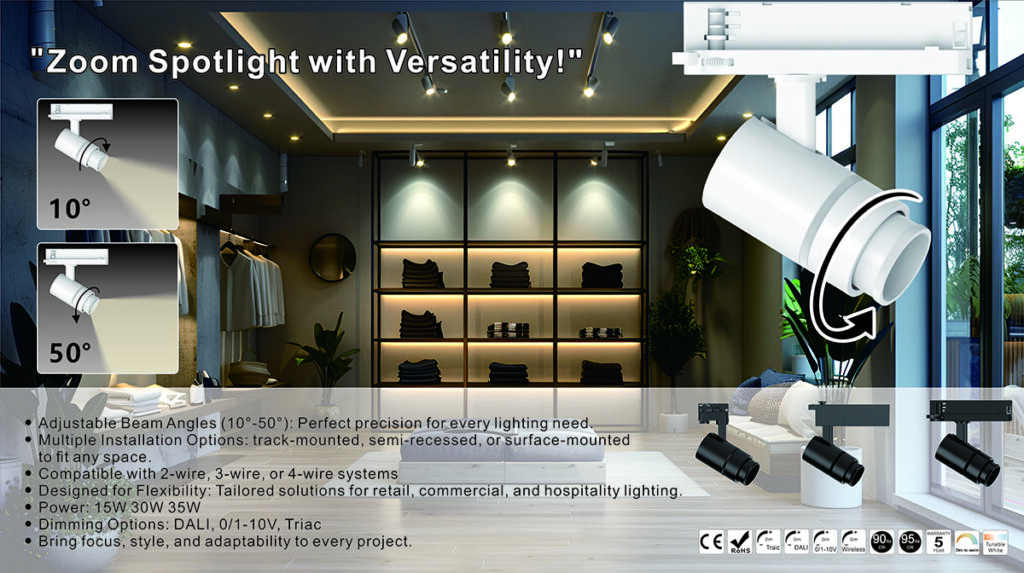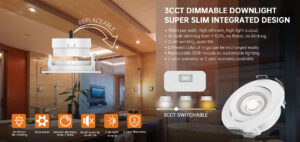Schienenbeleuchtungssysteme verstehen
Bei Schienenbeleuchtung werden Leuchten an einer durchgehenden Schiene montiert. Diese Schiene enthält elektrische Leiter. So lässt sich die Beleuchtung einfach positionieren und ausrichten. Schienenbeleuchtung ist sowohl im Wohn- als auch im Gewerbebereich beliebt. Ihre Flexibilität und ihr Stil machen sie für viele zur ersten Wahl.
Unterschiedliche Spannungen eignen sich für verschiedene Anwendungen. Jede Spannungsstufe beeinflusst Helligkeit, Sicherheit und Installationsanforderungen. Das Verständnis dieser Aspekte ist entscheidend für die Auswahl des passenden Systems. Erfahren Sie mehr über Schienenbeleuchtungssysteme hier.
240-V-Schienenbeleuchtung
In europäischen Ländern ist 240-V-Schienenbeleuchtung weit verbreitet. Sie wird direkt an das Stromnetz angeschlossen.
Wie funktioniert 240-V-Schienenbeleuchtungsarbeiten
240-V-Schienenbeleuchtungssysteme arbeiten direkt mit der Netzspannung. Die Schiene ist an den Stromkreis angeschlossen. Die an der Schiene befestigten Leuchten erhalten die 240-V-Stromversorgung. Die Leuchten wandeln diese Spannung dann in das für die Glühbirne oder LED benötigte Niveau um.
Vorteile von 240-V-Schienenbeleuchtung
- Hohe Leistungskapazität: 240-V-Systeme können mehr Leuchten und Glühbirnen mit höherer Wattzahl verarbeiten. Dadurch eignen sie sich für große Räume, die viel Licht benötigen.
- Effizienz: Eine höhere Spannung kann den Strom reduzieren, was zu einem geringeren Energieverlust über lange Distanzen führt.
- Kostengünstig: Im Vergleich zu Systemen mit niedrigerer Spannung werden weniger Transformatoren benötigt, was die Gesamtkosten potenziell senken kann.
Nachteile von 240-V-Schienenbeleuchtung
- Sicherheitsbedenken: Höhere Spannung erhöht das Risiko eines Stromschlags. Die Installation muss den strengen elektrischen Vorschriften entsprechen.
- Komplexität: Für die Installation ist in der Regel ein qualifizierter Elektriker erforderlich, was die anfänglichen Einrichtungskosten erhöht.
- Weniger Flexibilität: 240-V-Systeme bieten im Vergleich zu Niederspannungsalternativen möglicherweise weniger Optionen zum Dimmen und zur intelligenten Steuerung.
Anwendung für 240-V-Schienenbeleuchtung
- Gewerbeflächen: Einzelhandelsgeschäfte, Galerien und Büros profitieren von der hohen Leistungskapazität. kommerzielle Schienenbeleuchtung für diese Einstellungen.
- Große Wohngebiete: Ideal zur Beleuchtung großer Wohnzimmer, Küchen oder Studios.
- Industrielle Umgebungen: Fabriken und Lagerhallen können 240-V-Schienenbeleuchtung für die allgemeine Beleuchtung und Arbeitsbeleuchtung verwenden.
48-V-Schienenbeleuchtung
48-V-Schienenbeleuchtung erfreut sich zunehmender Beliebtheit. Sie bietet ein ausgewogenes Verhältnis zwischen Sicherheit und Effizienz.
Wie funktioniert 48-V-Schienenbeleuchtung?
48-V-Schienenbeleuchtungssysteme nutzen einen Transformator, um die Netzspannung (z. B. 240 V) auf 48 V herunterzutransformieren. Die 48-V-Leistung wird dann entlang der Schiene an die Leuchten verteilt. Diese niedrigere Spannung ermöglicht eine sicherere Handhabung und flexiblere Steuerungsmöglichkeiten.
Vorteile der 48-V-Schienenbeleuchtung
- Verbesserte Sicherheit: Eine niedrigere Spannung verringert das Risiko eines Stromschlags im Vergleich zu 240-V-Systemen.
- Flexibilität: 48-V-Systeme unterstützen eine große Bandbreite an Beleuchtungsdesigns und Steuerungsoptionen.
- Energieeffizienz: Optimiert für LED-Technologie, bietet hervorragende Lichtleistung bei minimalem Stromverbrauch.
Nachteile von 48-V-Schienenbeleuchtung
- Transformator erforderlich: Benötigt einen Transformator, um die Spannung der Netzversorgung herunterzutransformieren.
- Kosten: Die Anschaffungskosten können höher sein als bei 240-V-Systemen, da Transformatoren und Spezialkomponenten benötigt werden.
- Eingeschränkte Gerätekompatibilität: Stellen Sie sicher, dass die Vorrichtungen speziell für 48-V-Systeme ausgelegt sind.
Anwendungsszenarien für 48-V-Schienenbeleuchtung
- Moderne Häuser: Perfekt für moderne Innenräume und bietet eine Balance aus Stil und Sicherheit.
- Einzelhandelsdisplays: Bietet hervorragende Akzentbeleuchtung für die Präsentation von Produkten. Schienenstrahler zum Hervorheben bestimmter Elemente.
- Büros: Schafft eine angenehme und gut beleuchtete Arbeitsumgebung.
12-V-Schienenbeleuchtung
12-V-Schienenbeleuchtung ist für ihre Sicherheit und Vielseitigkeit bekannt. Sie ist eine beliebte Wahl für Wohn- und Dekorationsanwendungen.
Wie funktioniert 12-V-Schienenbeleuchtungsarbeiten
12-V-Schienenbeleuchtungssysteme reduzieren die Netzspannung mithilfe eines Transformators auf 12 V. Diese Niederspannung wird über die Schiene an die Leuchten weitergeleitet. Der Hauptvorteil liegt in der erhöhten Sicherheit, weshalb sich diese Systeme für Bereiche eignen, in denen Personen in engen Kontakt mit der Beleuchtung kommen können.
Vorteile der 12-V-Schienenbeleuchtung
- Maximale Sicherheit: Extrem niedrige Spannung minimiert das Risiko eines Stromschlags.
- Vielseitigkeit: Geeignet für eine Vielzahl von Beleuchtungsanwendungen, einschließlich Akzent- und Arbeitsbeleuchtung.
- DIY-freundlich: Im Vergleich zu Systemen mit höherer Spannung einfacher zu installieren und daher eine gute Wahl für Heimwerkerprojekte.
Nachteile von 12-V-Schienenbeleuchtung
- Spannungsabfall: Bei längeren Gleisstrecken kann es zu einem erheblichen Spannungsabfall kommen, der die Lichtintensität reduziert.
- Transformatorabhängigkeit: Erfordert einen Transformator, der die Gesamtkosten und Komplexität erhöhen kann.
- Begrenzte Leistung: Aufgrund von Leistungsbeschränkungen nicht für Anwendungen mit hoher Lumenzahl oder große Räume geeignet.
Anwendungsszenarien für 12V-Schienenbeleuchtung
- Akzentbeleuchtung: Ideal zum Hervorheben von Kunstwerken, architektonischen Details oder Waren.
- Unterschrankbeleuchtung: Ideal für Küchen und Arbeitsräume. Siehe die Leitfaden für Küchenschienenbeleuchtung für weitere Informationen.
- Freizeitfahrzeuge: Wird aufgrund seiner Sicherheit und seines geringen Stromverbrauchs häufig in Wohnmobilen und Booten verwendet
Vor- und Nachteile von Schienenbeleuchtung mit unterschiedlichen Spannungen
| Stromspannung | Vorteile | Nachteile |
|---|---|---|
| 240 V | Hohe Leistungskapazität, effizient für große Räume, kostengünstig (weniger Transformatoren) | Höheres Sicherheitsrisiko, aufwendige Installation, weniger Flexibilität bei Dimmung/Steuerung |
| 48 V | Erhöhte Sicherheit, flexible Designs, energieeffizient (optimiert für LED) | Erfordert Transformator, höhere Anschaffungskosten, eingeschränkte Leuchtenkompatibilität |
| 12 V | Maximale Sicherheit, vielseitig einsetzbar, DIY-freundlich | Spannungsabfall über lange Strecken, Transformatorabhängigkeit, begrenzte Leistung für hohen Lumenbedarf |
Schienenbeleuchtungsanwendungen für verschiedene Länder in Europa.
In diesem Abschnitt wird detailliert beschrieben, wie 240-V-, 48-V- und 12-V-Schienenbeleuchtungssysteme in bestimmten europäischen Ländern verwendet werden.
Deutschland
- 240-V-Schienenbeleuchtung: Wird aufgrund seiner hohen Leistungsfähigkeit vorwiegend in gewerblichen und industriellen Umgebungen eingesetzt. Die strikte Einhaltung der elektrischen Vorschriften gewährleistet Sicherheit. Deutsche Ingenieurskunst legt Wert auf Effizienz. 240-V-Systeme werden dort eingesetzt, wo eine hohe Lichtleistung entscheidend ist. Große Einzelhandelsgeschäfte nutzen 240 V zur Beleuchtung ganzer Räume. Fabriken nutzen sie als Arbeitsbeleuchtung.
- 48-V-Schienenbeleuchtung: Immer beliebter in modernen Wohnhäusern und Büros. Die verbesserten Sicherheitsfunktionen und die Energieeffizienz entsprechen dem deutschen Nachhaltigkeitskonzept. Sie unterstützt verschiedene Designs und eignet sich daher für moderne Räume. Architekturbüros integrieren 48-V-Schienenbeleuchtung in moderne Designs. Büros nutzen sie, um flexible und gut beleuchtete Umgebungen zu schaffen.
- 12-V-Schienenbeleuchtung: Normalerweise für bestimmte Anwendungen reserviert. Beispiele hierfür sind Akzentbeleuchtungen in Vitrinen, bei denen Sicherheit oberste Priorität hat. Heimwerker nutzen sie auch für kleinere Projekte. Museen nutzen 12 V, um Artefakte hervorzuheben. Bastler installieren sie für individuelle Beleuchtungslösungen.
Niederlande
- 240-V-Schienenbeleuchtung: Häufig in Einzelhandelsgeschäften und größeren Wohngebäuden zu finden. Energieeffizienz ist ein wichtiger Aspekt. LED-basierte 240-V-Systeme werden bevorzugt, um den Energieverbrauch zu senken. Supermärkte nutzen 240-V-Schienenbeleuchtung zur Beleuchtung von Gängen. Größere Häuser nutzen sie in offenen Wohnbereichen.
- 48-V-Schienenbeleuchtung: Bei Neubauten und Renovierungen immer beliebter. Das Engagement der Niederlande für nachhaltige Beleuchtungslösungen treibt diesen Trend voran. Architekten und Designer schätzen die Flexibilität und Sicherheit. Neue Häuser verfügen über 48 V, um modernen Beleuchtungsstandards gerecht zu werden. Renovierte Büros nutzen 48 V für energieeffiziente Beleuchtungsmodernisierungen.
- 12-V-Schienenbeleuchtung: Wird häufig in Heimwerkerprojekten verwendet. Es kann auch für kleinere Beleuchtungsinstallationen in Haus und Garten eingesetzt werden. Hausbesitzer installieren 12 V für Gartenbeleuchtungsprojekte. Heimwerker nutzen es für individuelle Unterschrankbeleuchtung in Küchen.
Skandinavien (Dänemark, Schweden, Norwegen)
- 240-V-Schienenbeleuchtung: Obwohl es immer noch verwendet wird, gibt es einen zunehmenden Trend zu energieeffizienteren Optionen. Die Anwendung findet sich in größeren Gewerbeflächen. Kaufhäuser nutzen weiterhin 240 V für die Allgemeinbeleuchtung.
- 48-V-Schienenbeleuchtung: Beliebt wegen seines schlanken, minimalistischen Designs. Die Kompatibilität mit Smart-Home-Systemen macht es zu einer beliebten Wahl für moderne Häuser. Intelligente Schienenleuchten 48-V-Netze werden immer häufiger eingesetzt. Wohnungen nutzen 48 V zur Integration in Smart-Home-Systeme. Moderne Büros nutzen sie für eine regulierbare und energieeffiziente Beleuchtung. In Norwegen werden 48 V aufgrund ihrer energiesparenden Vorteile zunehmend eingesetzt.
- 12-V-Schienenbeleuchtung: Wird hauptsächlich für dekorative und spezielle Beleuchtungsanwendungen eingesetzt. Der Schwerpunkt liegt auf der Schaffung von Atmosphäre und der Hervorhebung bestimmter Merkmale. Kunstgalerien nutzen 12 V, um Kunstwerke hervorzuheben. Innenarchitekten nutzen es, um stimmungsvolles Licht in Wohnzimmern zu erzeugen. Museen in Norwegen nutzen 12 V für empfindliche Displays.
Frankreich
- 240-V-Schienenbeleuchtung: Häufig in Gewerbegebäuden. Auch in älteren Wohngebäuden zu finden. Moderne Installationen nutzen zunehmend LED-Technologie zur Energieeinsparung. Boutiquen nutzen 240-V-Stromversorgung für die Allgemeinbeleuchtung. Historische Gebäude werden aus Energieeffizienzgründen auf LED-basierte 240-V-Systeme umgerüstet.
- 48-V-Schienenbeleuchtung: Immer beliebter in hochwertigen Wohn- und Gewerbeprojekten. Ästhetik und Energieeffizienz stehen bei diesen Projekten im Vordergrund. Luxusapartments verfügen über 48 V für stilvolle Beleuchtungslösungen. Edle Restaurants nutzen sie, um Atmosphäre zu schaffen und architektonische Details hervorzuheben.
- 12-V-Schienenbeleuchtung: Reserviert für Nischenanwendungen, bei denen aus Sicherheitsgründen Niederspannung bevorzugt wird. Beispiele hierfür sind die Beleuchtung in sensiblen Umgebungen oder in der Nähe von Wasserquellen. Spas nutzen 12 V für schwache, sichere Beleuchtung von Wasserflächen. Gewächshäuser nutzen sie für spezielle Pflanzenbeleuchtung.
Nutzung von Schienenbeleuchtung nach Ländern.
| Land | 240-V-Schienenbeleuchtung | 48-V-Schienenbeleuchtung | 12-V-Schienenbeleuchtung |
|---|---|---|---|
| Deutschland | Gewerbe/Industrie (Einzelhandelsgeschäfte, Fabriken), Hohe Lichtleistung, Allgemein- und Arbeitsbeleuchtung | Moderne Häuser/Büros (Architekturbüros, Büros), Energieeffizienz, flexible Designs, zeitgenössische Räume | Akzentbeleuchtung (Museen), Vitrinen, DIY-Projekte (Bastler), individuelle Beleuchtungslösungen |
| Niederlande | Einzelhandel/Große Wohngebäude (Supermärkte, offene Wohnhäuser), Energieeffiziente LEDs, Allgemeinbeleuchtung | Neubau/Renovierungen (Neubauwohnungen, Bürosanierungen), Nachhaltige Lösungen, Flexibilität, Sicherheit, Moderne Standards, Energieeffiziente Beleuchtungsmodernisierungen | Heimwerkerprojekte (Hausbesitzer), Kleininstallationen (Gärten), individuelle Unterschrankbeleuchtung (Küchen) |
| Skandinavien (Dänemark, Schweden, Norwegen) | Größere Gewerbeflächen (Kaufhäuser), schrittweise Umstellung auf effiziente LEDs, Allgemeinbeleuchtung | Moderne Häuser (Wohnungen), Smart-Home-Systeme, minimalistisches Design, anpassbare Beleuchtung, Energieeffizienz, zunehmende Akzeptanz in Norwegen | Dekorativ, Spezialanwendungen (Kunstgalerien, Museen in Norwegen), Ambiente (Innenarchitekten), Hervorheben von Merkmalen |
| Frankreich | Gewerbe (Boutiquen), Ältere Wohnhäuser (Historische Häuser), LED-Upgrades, Allgemeinbeleuchtung, Energieeinsparungen | High-End-Projekte (Luxuswohnungen, Restaurants), Ästhetik und Energieeinsparungen, stilvolle Beleuchtungslösungen, Hervorhebung architektonischer Details | Nischenanwendungen (Spas, Gewächshäuser), sicherheitskritische Umgebungen, Schwachlichtbeleuchtung, spezielle Pflanzenbeleuchtung |
Radians Lighting: Innovative Schienenbeleuchtungslösungen
Radians Beleuchtung steht an der Spitze der Beleuchtungsbranche. Das Unternehmen ist bekannt für sein Engagement für Qualität, Innovation und Nachhaltigkeit. Mit dem Schwerpunkt auf LED-Technologie bietet Radians Lighting eine breite Palette an Schienenbeleuchtungslösungen. Diese Lösungen erfüllen unterschiedliche Bedürfnisse und Wünsche.
Radians Lighting zeichnet sich durch die individuelle Produktanpassung aus. Das Unternehmen arbeitet eng mit seinen Kunden zusammen. So wird sichergestellt, dass jedes Beleuchtungssystem spezifische Anforderungen erfüllt. Das Designteam verbindet Ästhetik mit Funktionalität. Das Ergebnis sind Beleuchtungslösungen, die sowohl schön als auch praktisch sind.
Die Qualitätskontrolle ist ein Eckpfeiler der Geschäftstätigkeit von Radians Lighting. Jedes Produkt wird strengen Tests unterzogen. Dies stellt sicher, dass es höchsten Leistungs- und Haltbarkeitsstandards entspricht. Von der Materialauswahl bis zur Endmontage wird jedes Detail sorgfältig überwacht.
Radians Lighting bietet eine Vielzahl von Schienenbeleuchtungsprodukten an:
- Dekorative Schienenbeleuchtung: Verleiht jedem Raum einen Hauch von Eleganz.
- Dimmbare Schienenbeleuchtung: Ermöglicht die Anpassung der Lichtintensität. dimmbare Schienenbeleuchtung für flexible Beleuchtungsoptionen.
- Moderne LED-Schienenbeleuchtung: Sorgt für energieeffiziente und stilvolle Beleuchtung.
Radians Lighting hat sich der Bereitstellung innovativer Beleuchtungslösungen verschrieben. Diese Lösungen steigern die Schönheit und Funktionalität jeder Umgebung. Sie konzentrieren sich auch auf nachhaltige Beleuchtung Praktiken.
Auswahl der richtigen Spannung: Wichtige Überlegungen
Die Wahl der richtigen Spannung für Schienenbeleuchtung hängt von mehreren Faktoren ab. Beachten Sie diese Punkte, um die beste Wahl zu treffen:
- Anwendung: Bestimmen Sie den Hauptzweck des Beleuchtungssystems. Akzentbeleuchtung kann 12 V erfordern. Große Gewerbeflächen können von 240 V profitieren.
- Raumgröße: Größere Bereiche benötigen Systeme mit höherer Spannung, um die Helligkeit aufrechtzuerhalten und den Spannungsabfall zu minimieren.
- Budget: Berücksichtigen Sie die Anschaffungskosten des Systems. Dazu gehören Transformatoren und Installationskosten.
- Sicherheit: Priorisieren Sie die Sicherheit basierend auf der Umgebung. Überlegen Sie, wer den Raum nutzen wird.
- Installation: Prüfen Sie, ob Sie die Anlage selbst installieren können. Oder ob Sie einen professionellen Elektriker benötigen.
- Vorschriften: Stellen Sie sicher, dass die örtlichen Elektrovorschriften und -bestimmungen eingehalten werden.
- Energieeffizienz: Entdecken Sie LED-Optionen, um Ihren Energieverbrauch zu senken und Ihre Stromrechnung zu optimieren. Erfahren Sie mehr über Energielabels für den EU-Markt.
Vergleich der verschiedenen Spannungen von Schienenleuchten
| Besonderheit | 240-V-Schienenbeleuchtung | 48-V-Schienenbeleuchtung | 12-V-Schienenbeleuchtung |
|---|---|---|---|
| Sicherheit | Hohes Stromschlagrisiko | Reduziertes Risiko eines Stromschlags | Sehr geringes Stromschlagrisiko |
| Leistungskapazität | Hoch, geeignet für große Räume | Mittel, für verschiedene Anwendungen geeignet | Niedrig, auf kleinere Bereiche beschränkt und Akzentbeleuchtung |
| Installation | Erfordert einen qualifizierten Elektriker | Erfordert möglicherweise eine professionelle Installation | DIY-freundlich |
| Kosten | Geringere Anschaffungskosten, weniger Transformatoren | Höhere Anschaffungskosten, Transformator erforderlich | Moderate Kosten, erfordert Transformator |
| Anwendungen | Gewerbe, große Wohnhäuser, Industrie | Moderne Häuser, Einzelhandelsdisplays, Büros | Akzentbeleuchtung, Unterschrankbeleuchtung, Wohnmobile |
| Energieeffizienz | Kann bei richtiger Einrichtung effizient sein | Optimiert für LED-Technologie | Kann mit LED-Lampen effizient sein |
| Spannungsabfall | Minimal | Mäßig | Signifikant über weite Distanzen |
Übersichtstabelle
| Faktor | 240-V-Schienenbeleuchtung | 48-V-Schienenbeleuchtung | 12-V-Schienenbeleuchtung |
|---|---|---|---|
| Sicherheit | Hohes Risiko | Mittleres Risiko | Geringes Risiko |
| Leistung | Hoch | Medium | Niedrig |
| Installation | Professional | Semiprofessionell | Heimwerken |
| Kosten | Mäßig | Hoch | Mäßig |
| Beste Verwendung | Kommerziell | Wohnen/Einzelhandel | Akzentbeleuchtung |
Abschluss
Die Wahl der Spannung für Ihre Schienenbeleuchtung bestimmt Sicherheit, Effizienz und optische Wirkung Ihrer Räumlichkeiten für viele Jahre. Indem Sie die Vorteile von 240-V-, 48-V- und 12-V-Systemen abwägen und mit einem Branchenführer wie Radians Lighting zusammenarbeiten, erhalten Sie eine Lösung, die höchsten Ansprüchen an Leistung und Nachhaltigkeit genügt. Entdecken Sie, wie Radians Ihre Vision verwirklichen kann, und besuchen Sie deren Website. Schienenbeleuchtungslösungen oder wenden Sie sich für eine persönliche Beratung an das Expertenteam.









